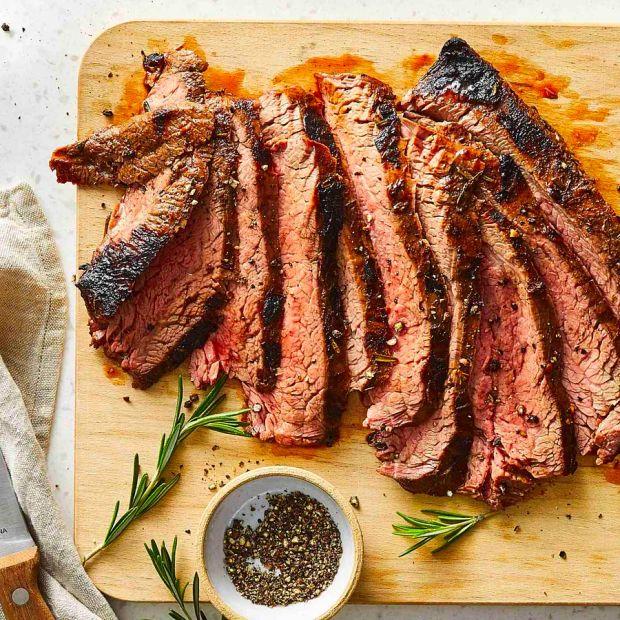How Skirt, Flank, Hanger, and Flat Iron Steaks Differ from Each Other

Cuts like ribeyes, filet mignons, and T-bone steaks are easy to identify at the butcher's counter. They’re often bone-in, thick, heavily marbled, and usually hand-cut, which makes them stand out. In other words, I can spot a New York strip a mile away.
But when you venture beyond these premium cuts from the rib, short loin, and sirloin sections (the back of the cow) and move toward the lower abdomen in the short plate and flank region, things start to blur. These cuts all tend to look similar—long, lean, and lacking heavy marbling. This is where you'll find skirt, hanger, flank, and flat iron steaks.
These cuts are leaner and tougher because they come from the more active parts of the cow. However, they’re also more affordable compared to the pricier cuts from the back area. While they might have tougher fibers and more silver skin, they still pack a lot of flavor—it's all about how you prepare them. A good rule of thumb: slice them thinly before serving.
Now, let’s explore the subtle yet significant differences between these often-confused steak cuts.
Skirt Steak Cut

Skirt steak comes from the short plate section of the cow and is the fattiest cut among the four. It’s derived from two distinct muscles in the chest and abdomen, known as the inside (transversus abdominis) and outside (diaphragm) skirt muscles. This cut is longer (sometimes up to 24 inches), narrower, and a bit thinner than flank steak. It’s best cooked to medium-rare for a tender, juicy result. Skirt steak is also known for having a more intense, beefy flavor compared to flank.
Must-Try Skirt Steak Recipes:
- Grilled Coffee and Cola Skirt Steak
- Balsamic Skirt Steak
- Argentinian Skirt Steaks
- Tender Juicy Skirt Steak
If you've ever savored a sizzling plate of steak fajitas, chances are you’ve had skirt steak. Due to its thick grain and connective tissue, this cut absorbs marinades exceptionally well and responds beautifully to a high heat sear on the grill or in a cast iron pan. (Tip: Marinate skirt steak for anywhere between 30 minutes to 24 hours—the longer it marinates, the more flavor it soaks up.) To make cooking easier, cut this long steak into smaller pieces. For the juiciest, most flavorful results, always slice against the grain.
Flank Steak Cut

Flank steak is another cut that’s often confused with skirt steak. While both are similar, flank steak is wider, shorter, and thicker. It comes from the flank section of the cow, located even lower on the abdomen than skirt steak, and contains slightly less fat.
Must-Try Flank Steak Recipes:
- Marinated Flank Steak
- Overnight Marinated Flank Steak
- Tuscan Flank Steak
- Grilled Balsamic and Soy Marinated Flank Steak
Flank steak is a bit tougher and more fibrous than skirt steak, but it shares many similar qualities, especially its ability to absorb marinades. A tangy, flavorful marinade is an excellent way to tenderize tougher cuts like flank steak. Flank is perfect for grilling or pan-searing to a juicy medium-rare. It works great in everything from carne asada tacos to hearty sandwiches. You can even stuff and roll flank steak after marinating for a deliciously impressive dinner idea.
Hanger Steak Cut

Hanger steak is cut from the lower abdomen and diaphragm area, located between the rib and loin. It’s a long, narrow, and thick cut of beef. Since it comes from a less active part of the cow compared to flank and skirt, it is naturally more tender. However, like flank and skirt steak, it still benefits from marinating, though it's not strictly necessary. It’s best cooked to medium-rare, as cooking it beyond that can result in a tougher texture.
Hanger Steak Recipes You Must Try:
- Grilled Hanger Steak with Roasted Shallot Port Demi Sauce
- Gabe's Coffee Crusted Hanger Steak with Apple, Fennel, and Herb Salad
- Butcher's Steak
Hanger steak, much like skirt steak, has more fat and marbling than flank steak. While it’s a less commonly known cut (sometimes called 'butcher’s steak' because it’s favored by butchers, though not as popular with consumers), hanger steak is gaining in popularity. Its price may vary depending on where you buy it. In many cases, hanger steak can be used interchangeably with skirt or flank steak.
Flat Iron Steak Cut

This flat cut of beef comes from the area near the chuck/shoulder of the cow. It’s not as long or narrow as some other cuts; instead, it has a rectangular shape and a consistent thickness throughout. It also contains more marbling than the other flat cuts. While you can cook it as-is, marinating the steak beforehand will help tenderize the fibers and enhance its flavor. That said, it’s already quite rich and flavorful on its own.
Must-Try Flat Iron Steak Recipes:
- Flat Iron Steak with Mushrooms
- Foolproof Flat Iron Steaks
- Perfect Flat Iron Steak
- Marinated Flat Iron Steak
Flat iron steak can be swapped with skirt, flank, or hanger steak in most recipes. Like the others, it’s best cooked no further than medium-rare to avoid toughness. If you're looking for a budget-friendly, flavorful steak for sandwiches, flat iron is an excellent choice—easy to prepare, rich in taste, and affordable.
Evaluation :
5/5



